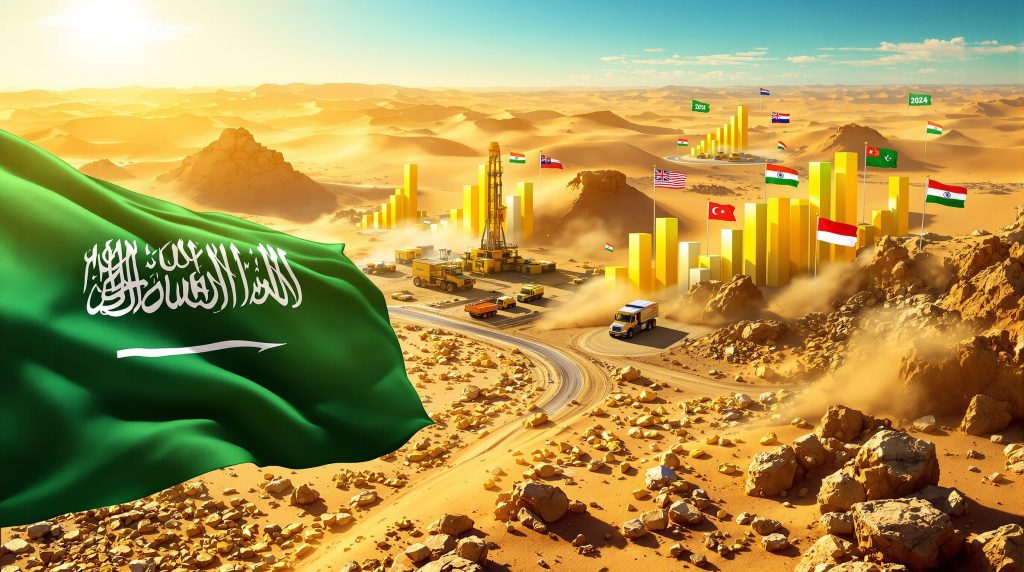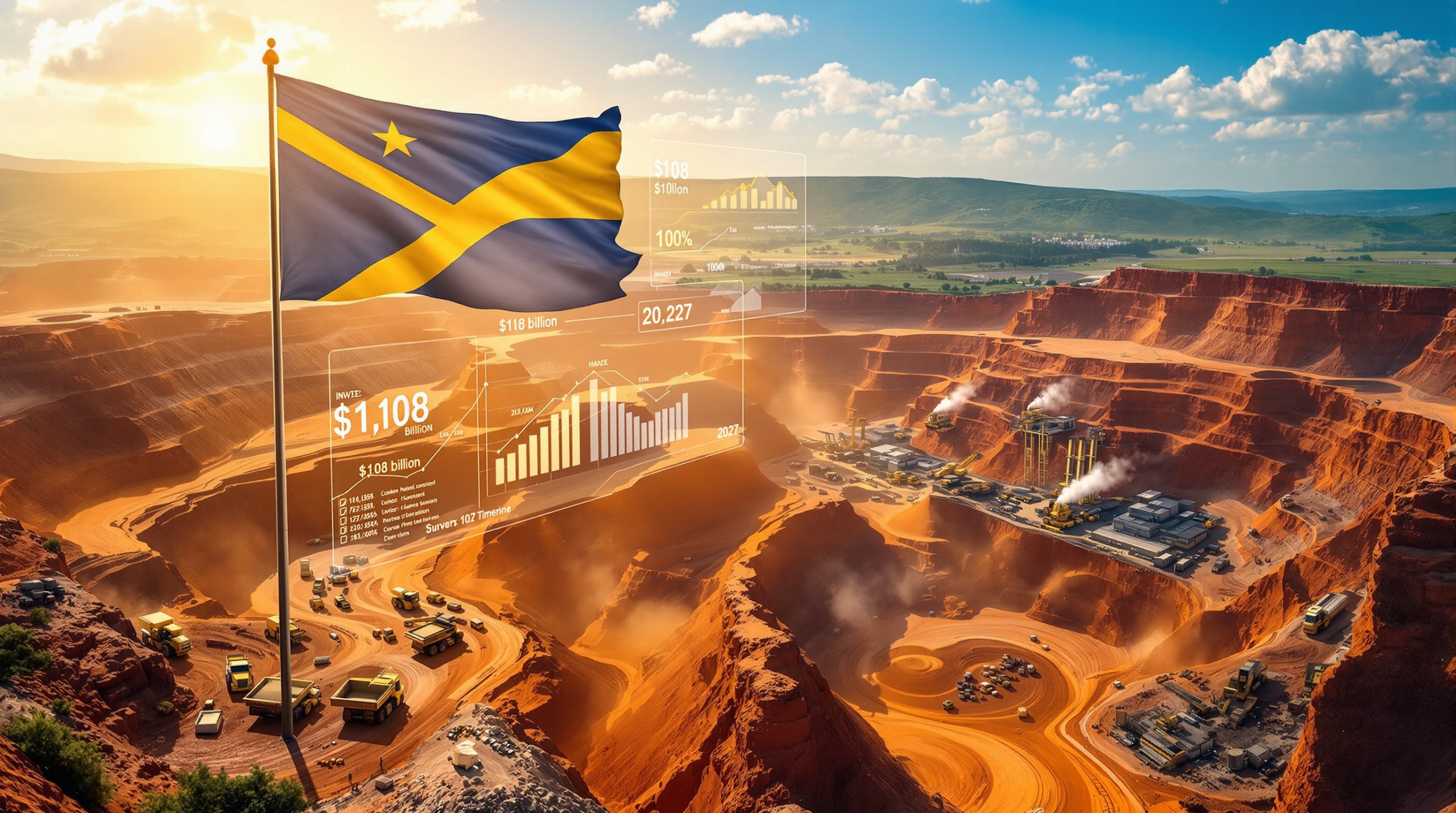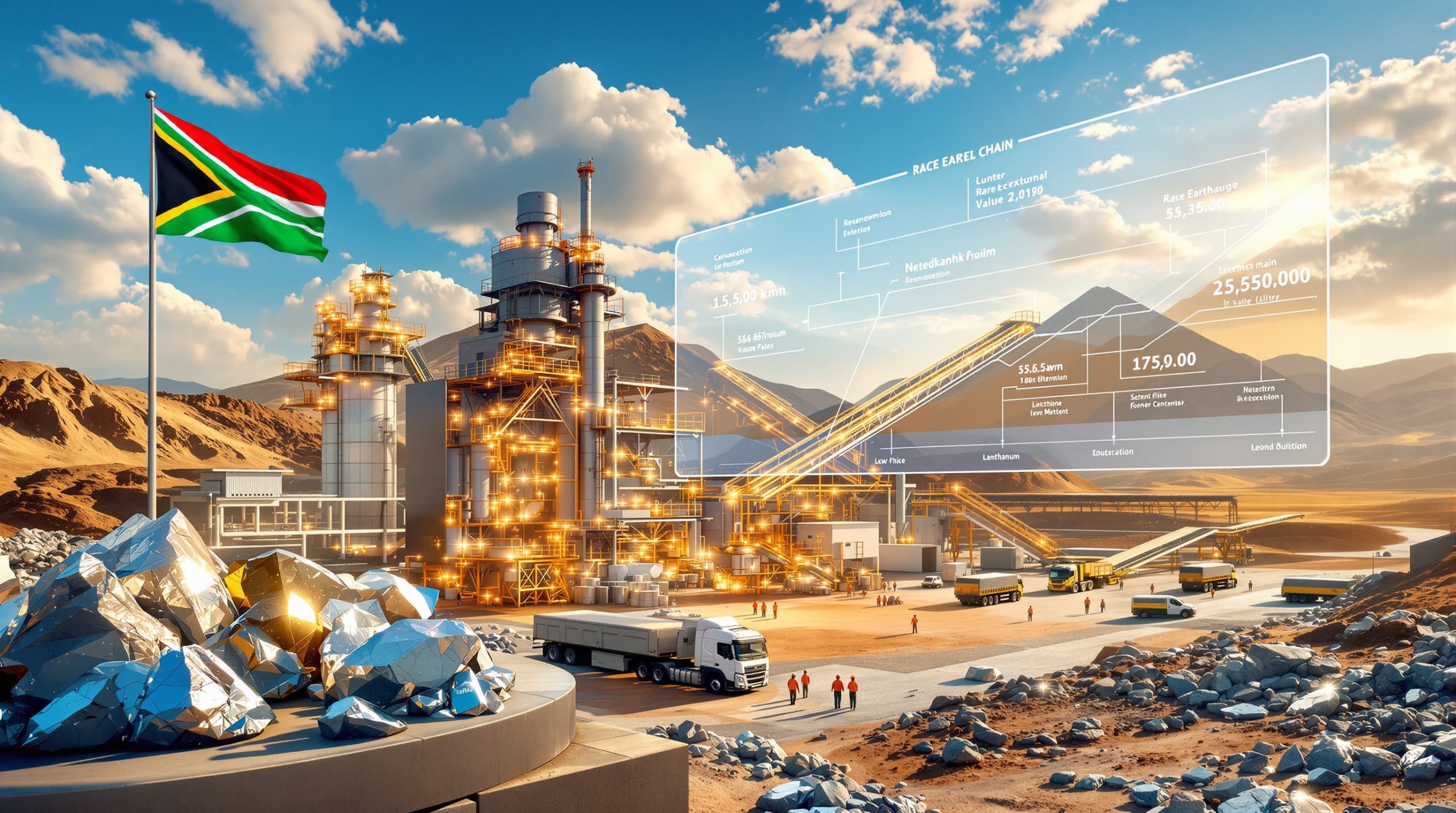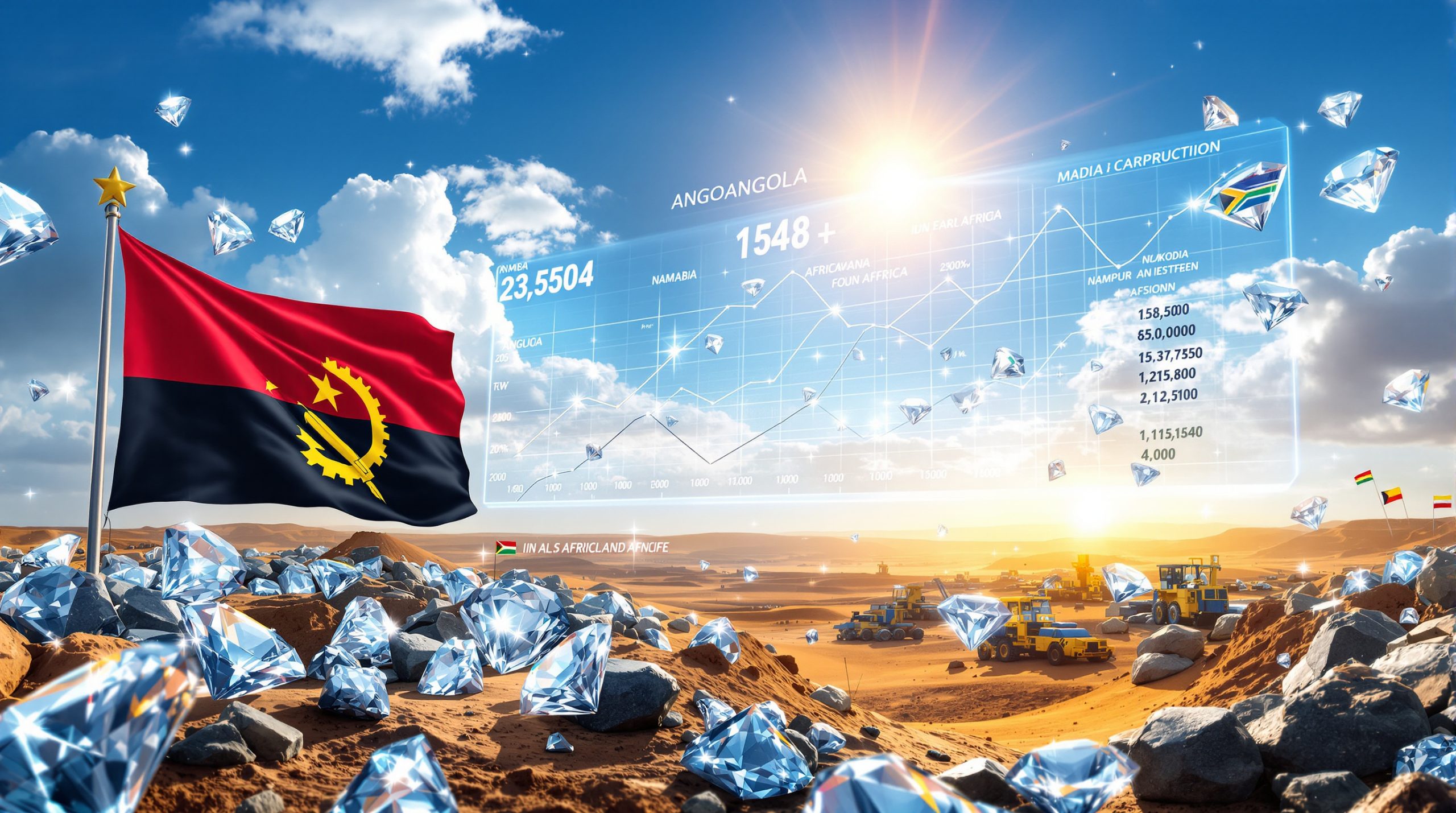Understanding Saudi Arabia's Strategic Mining Transformation
Saudi Arabia mining exploration expansion represents a cornerstone of the Kingdom's ambitious economic diversification strategy, fundamentally reshaping the nation's approach to resource development beyond traditional hydrocarbon dependence. This transformation reflects a systematic effort to establish mining as a critical economic pillar alongside oil and petrochemicals, positioning the Kingdom for sustained growth in the global mining landscape.
The strategic framework underpinning this expansion centres on Vision 2030's comprehensive economic blueprint, which explicitly targets mining as the third pillar of national economic development. This initiative recognises the Kingdom's vast geological potential, estimated at over $2.5 trillion in untapped mineral wealth, as a foundation for long-term economic sustainability and regional development across Saudi territories.
The Vision 2030 Mining Framework
Vision 2030's mining component represents more than resource extraction objectives, encompassing integrated industrial development, technology transfer, and sustainable economic growth models. The framework positions mineral development as essential infrastructure for supporting downstream manufacturing, critical minerals energy transition, and global supply chain integration.
Economic diversification imperatives drive this strategic focus, particularly as global energy transitions accelerate demand for critical minerals while traditional hydrocarbon markets face long-term uncertainty. The Kingdom's leadership recognises mining industry evolution as essential for maintaining economic competitiveness and regional influence in evolving global commodity markets.
Economic Diversification Imperatives
The Kingdom's mineral wealth distribution spans 933 exploration locations currently at various development stages, representing significant untapped potential across gold, copper, zinc, and associated mineral categories. This resource base provides the foundation for establishing Saudi Arabia as a major player in global supply chains, particularly those supporting renewable energy infrastructure and advanced manufacturing sectors.
Strategic positioning leverages the Kingdom's advantageous geographic location, providing access to Asian, European, and African markets through established transportation networks and emerging logistical infrastructure. This positioning enables Saudi Arabia to influence regional mineral trade flows whilst capturing value-added processing opportunities within domestic industrial zones.
What Drives the Explosive Growth in Exploration Investment?
The Kingdom has experienced remarkable financial commitment escalation in mineral exploration, with spending patterns revealing extraordinary year-over-year increases that position Saudi Arabia mining exploration expansion amongst the world's most active exploration jurisdictions. According to Saudi Arabia's Ministry of Industry and Mineral Resources, exploration spending increased fivefold over four years, reaching SAR 1.05 billion (USD 280.5 million) in 2024, compared to SAR 205 million (USD 55 million) in 2020.
This growth trajectory demonstrates sustained investor confidence in Saudi Arabia's mineral potential, supported by comprehensive regulatory reforms and transparent licensing systems that attract both domestic and international capital. Furthermore, the acceleration reflects coordinated efforts between government geological survey programs and private sector investment initiatives, creating synergistic effects across the entire exploration ecosystem.
Private Sector Investment Surge
Private sector exploration spending exhibited exceptional growth, increasing from SAR 155 million (USD 41.3 million) in 2020 to SAR 770 million (USD 205 million) in 2024, representing a 164% increase in private sector exploration licences over the four-year period. This dramatic expansion indicates growing market confidence in the Kingdom's regulatory environment and resource potential.
| Year | Private Exploration Spending | Government Geological Programmes | Total Investment |
|---|---|---|---|
| 2020 | SAR 155M (USD 41.3M) | SAR 11M (USD 2.9M) | SAR 205M (USD 55M) |
| 2023 | Data not disaggregated | Data not disaggregated | SAR 501M (USD 133.5M) |
| 2024 | SAR 770M (USD 205M) | SAR 180M (USD 48M) | SAR 1.05B (USD 280.5M) |
Source: Mining Weekly, October 24, 2025, citing Saudi Arabia's Ministry of Industry and Mineral Resources
Government spending through geological programmes demonstrated even more dramatic growth, expanding from SAR 11 million (USD 2.9 million) in 2020 to SAR 180 million (USD 48 million) in 2024, reflecting a 16-fold increase in public sector commitment to mineral exploration infrastructure and data collection programmes.
International Capital Attraction
Foreign investment now represents 66% of total mining investment, with exploration companies from Australia, Canada, China, India, Indonesia, and the United Kingdom establishing significant operations across Saudi territories. Consequently, this international participation brings advanced exploration technologies, proven development methodologies, and global market access to Saudi mineral projects.
The number of active exploration companies increased from 6 companies in 2020 to 226 companies in 2024, representing a 38-fold expansion that indicates both reduced barriers to entry and growing investor confidence in the Kingdom's long-term mining potential. This remarkable growth reflects successful regulatory modernisation and transparent licensing processes that attract international participation.
Two-thirds of tender round participants represent foreign or consortium bidders, demonstrating the Kingdom's success in attracting international expertise whilst maintaining strategic control over mineral resource development. This balanced approach ensures technology transfer and best practice implementation whilst preserving national economic interests.
How Has the Regulatory Environment Transformed?
Saudi Arabia's regulatory modernisation represents one of the most comprehensive mining sector reforms globally, designed to attract international investment whilst maintaining transparent governance standards and environmental stewardship requirements. These reforms have fundamentally altered investor perceptions of Saudi Arabia as a mining destination.
According to the 2024 Fraser Institute report, Saudi Arabia achieved remarkable progress in global mining investment attractiveness rankings, advancing from 104th to 23rd place globally over the past decade. This 81-position improvement represents one of the most dramatic regulatory environment transformations in international mining sector history.
Fraser Institute Rankings Improvement
The Kingdom's regulatory transformation earned recognition across multiple Fraser Institute assessment categories:
• Overall Investment Environment Improvement Pace: Ranked 1st globally (2018-2023 period)
• Mineral Licensing Policy Perception: Ranked 2nd worldwide
• Mining Fiscal Policy: Entered top 10 countries globally
• Regulatory and Legislative Framework: Positioned amongst the world's best jurisdictions
Source: Mining Weekly, October 24, 2025, citing 2024 Fraser Institute report
These achievements reflect systematic efforts to modernise licensing procedures, streamline approval processes, and establish transparent, competitive allocation mechanisms that provide certainty for long-term investment planning and project development.
Licensing System Modernisation
The transparent auction system evolution demonstrates the Kingdom's commitment to competitive, merit-based resource allocation. The system expanded from offering a single site in 2022 to 29 sites in 2025, with committed exploration spending across eight completed tender rounds reaching SAR 1.2 billion (USD 320 million).
This systematic expansion reflects growing government confidence in market demand and investor capability to deliver on exploration commitments. The auction mechanism ensures competitive pricing whilst maintaining exploration spending obligations that guarantee active development of allocated territories.
Licensing reform encompasses environmental compliance requirements, community engagement protocols, and technological innovation standards that align with international best practices whilst supporting sustainable development objectives across the Kingdom's mineral-rich regions. Additionally, these measures support the broader Saudi exploration licenses framework for systematic resource development.
What Geological Wealth Underlies This Expansion?
The Kingdom possesses extensive mineral resources distributed across 933 exploration locations at various development stages, representing significant global supply chain potential across multiple commodity categories. This geological wealth provides the foundation for sustained exploration investment and long-term mining sector development.
Resource distribution analysis reveals strategic focus on high-value commodities with strong global demand fundamentals. Gold and associated minerals account for 691 locations (74% of total portfolio), whilst base metals including zinc and copper represent 242 locations (26% of portfolio), indicating balanced exposure to both precious metals and industrial commodity markets.
Primary Mineral Resource Distribution
Exploration Location Breakdown:
• Gold and associated minerals: 691 locations
• Base metals (zinc, copper): 242 locations
• Total exploration portfolio: 933 locations
Source: Mining Weekly, October 24, 2025, citing Saudi Arabia's Ministry of Industry and Mineral Resources
Preliminary Resource Estimates indicate substantial mineral potential:
• Gold potential: Approximately 67 million ounces
• Copper reserves: 3.87 million tonnes
• Zinc deposits: 5.24 million tonnes
These preliminary estimates represent early-stage geological assessments with significant potential for expansion through systematic exploration programmes and advanced geological survey techniques currently being implemented across the Kingdom's mineral-rich territories.
Proven Reserve Classifications
Current proven mineral reserves, representing deposits meeting industry classification standards for mining feasibility, include approximately 12 million ounces of gold, 60,000 tonnes of copper, and 33,000 tonnes of zinc. However, ongoing exploration activities are expected to expand these classifications significantly as geological data collection and analysis programmes advance.
The substantial difference between preliminary resource estimates and proven reserves indicates significant exploration upside potential, with systematic geological survey programmes targeting conversion of resources to reserves through detailed drilling programmes, metallurgical testing, and economic feasibility assessments.
Resource quality assessments and geological formation analysis support long-term mining development potential across multiple commodity categories, positioning Saudi Arabia as a significant contributor to global mineral supply chains, particularly those supporting clean energy transitions and advanced manufacturing sectors.
Which Companies Are Leading the Exploration Boom?
The dramatic increase from 6 active exploration companies in 2020 to 226 companies in 2024 represents a 38-fold expansion, indicating robust industry confidence and diversified participation across domestic and international investor categories. This growth reflects successful regulatory modernisation and transparent licensing processes that attract global mining expertise.
International participation dominates the investment landscape, with foreign investors accounting for 66% of total mining investment compared to 34% from domestic investors. This distribution brings international expertise and capital whilst maintaining significant local participation in the Kingdom's mineral development trajectory.
International Consortium Participation
Two-thirds of tender round participants represent foreign or consortium bidders from established mining jurisdictions, bringing advanced exploration technologies and international best practices to Saudi geological surveys. Countries represented include Australia, Canada, China, India, Indonesia, and the United Kingdom, indicating global recognition of Saudi Arabia's mineral potential.
Committed exploration spending across the Kingdom's eight tender rounds has reached SAR 1.2 billion (USD 320 million), demonstrating substantial financial commitment from participating companies and consortiums. This spending represents binding obligations that ensure active exploration and development across allocated territories.
The auction system expansion from 1 site during the first round (2022) to 29 sites during the most recent auction (2025) reflects growing investor confidence and government capacity to manage large-scale, simultaneous exploration programmes across multiple geological territories.
Local-International Partnership Models
The balanced investment structure combines international expertise with local knowledge, creating sustainable development frameworks that benefit regional communities whilst advancing exploration objectives. Domestic participation ensures technology transfer and local capacity development alongside foreign direct investment.
Partnership models facilitate knowledge sharing between international companies with proven track records and local firms with regional expertise, creating synergistic effects that accelerate exploration timelines whilst building domestic mining sector capabilities for long-term sustainability.
This collaborative approach supports Vision 2030's broader economic diversification objectives by establishing mining as a sustainable employment generator and technology development platform across the Kingdom's mineral-rich regions.
How Does Exploration Spending Compare Globally?
Saudi Arabia's exploration intensity has positioned the Kingdom amongst the world's most active mining jurisdictions, with spending metrics demonstrating exceptional growth rates that outpace most international competitors. Moreover, exploration spending density provides standardised metrics for cross-jurisdictional comparison, revealing Saudi Arabia mining exploration expansion's remarkable trajectory.
Exploration spending increased from SAR 105 (USD 28) per km² in 2020 to SAR 539 (USD 143.7) per km² in 2024, moving the Kingdom's global ranking from 20th to 12th place amongst mining jurisdictions worldwide. This 8-position improvement reflects sustained investment commitment and systematic exploration programme expansion.
Per-Square-Kilometre Investment Analysis
The per-square-kilometre metric standardises for geographic territory size, enabling valid comparison across mining jurisdictions with different land areas. Saudi Arabia's improvement from USD 28 to USD 143.7 per km² represents a 413% increase over the four-year period, demonstrating exceptional exploration intensity growth.
| Year | SAR/km² | USD/km² | Global Ranking |
|---|---|---|---|
| 2020 | SAR 105 | USD 28 | 20th place |
| 2024 | SAR 539 | USD 143.7 | 12th place |
Source: Mining Weekly, October 24, 2025
This spending density positions Saudi Arabia amongst established mining jurisdictions, indicating successful transformation from emerging to mature exploration market status within a remarkably short timeframe. Furthermore, this performance aligns with broader mining investment trends globally.
Compound Annual Growth Rate Achievement
The 50% compound annual growth rate in exploration spending represents arguably one of the highest globally amongst major mining jurisdictions, reflecting sustained commitment to mineral sector development and successful attraction of international capital to Saudi exploration projects.
Over 70% of the Kingdom's total exploration spending was expended on grassroots projects in new and underexplored areas, marking the highest proportion amongst 21 countries included in global comparison analysis. This focus on early-stage exploration indicates confidence in discovering new mineral deposits across previously unexplored geological territories.
The grassroots exploration emphasis distinguishes Saudi Arabia from many established mining jurisdictions that focus primarily on expanding known deposits, suggesting significant potential for major new discoveries across the Kingdom's extensive geological formations.
What Types of Exploration Projects Dominate Current Activity?
The Kingdom's exploration portfolio demonstrates strategic balance between grassroots discovery programmes and advanced development projects, ensuring sustainable pipeline progression from initial exploration through potential mining operations. This balanced approach supports both near-term development opportunities and long-term resource base expansion.
Advanced-stage projects, representing those closest to potential mine development, accounted for the largest share of 2024 spending at SAR 349 million (USD 93 million), followed by early-stage exploration at SAR 263 million (USD 70.1 million). This distribution indicates healthy pipeline progression from discovery phases toward development-ready projects.
Project Stage Distribution (2024)
Advanced-stage projects: SAR 349 million (USD 93 million)
• Closest to potential mine development
• Detailed geological assessment and feasibility studies
• Environmental and social impact assessments
• Infrastructure development planning
Early-stage exploration: SAR 263 million (USD 70.1 million)
• Regional geological surveys and target identification
• Initial drilling programmes and resource estimation
• Geological modelling and exploration strategy development
• Community engagement and environmental baseline studies
Grassroots projects: Over 70% of total spending
• Highest proportion amongst 21 compared countries globally
• Focus on previously unexplored geological territories
• Systematic regional survey programmes
• Technology-driven discovery methodologies
Drilling Activity Leadership
Drilling operations represent the largest exploration expenditure component, increasing from SAR 152 million in 2023 to SAR 230 million in 2024, indicating intensive field activity across multiple sites and geological formations. This drilling intensity reflects transition from preliminary surveys to detailed resource definition programmes.
Total exploration spending on licences increased from SAR 292 million to SAR 770 million in 2024, reflecting intensified field activity and growing confidence in resource potential across allocated exploration territories. This spending increase demonstrates successful progression from licensing to active exploration phases.
The emphasis on drilling activity indicates systematic progression toward resource definition and feasibility assessment phases, supporting the Kingdom's objective of establishing mining as a sustainable economic pillar through proven mineral reserves and development-ready projects.
What Role Does Government Infrastructure Play?
The Saudi Geological Survey (SGS) provides essential foundation support through comprehensive geological database development and accelerated exploration programmes that reduce investment risks for private sector participants. Government infrastructure investment creates the enabling environment for successful commercial exploration and development activities.
Government geological programme spending increased dramatically from SAR 11 million (USD 2.9 million) in 2020 to SAR 180 million (USD 48 million) in 2024, representing a 16-fold increase in public sector commitment to geological survey infrastructure and data collection programmes.
Regional Geological Survey Programme (RGP)
The RGP develops comprehensive national geological databases providing essential baseline information for private sector exploration targeting and risk assessment. This systematic initiative covers geological mapping, geochemical analysis, and geophysical surveys across the Kingdom's mineral-rich territories.
Database development includes:
• Detailed geological mapping at multiple scales
• Geochemical sampling and analysis programmes
• Geophysical survey data collection and interpretation
• Mineral occurrence documentation and classification
• Historical exploration data compilation and digitisation
Accelerated Exploration Programme (AEP)
The AEP focuses on rapid data collection and analysis to identify high-potential mineral zones, reducing exploration timelines and investment risks for participating companies. This programme utilises advanced technologies and systematic survey methodologies to accelerate the transition from regional surveys to detailed exploration programmes.
Programme components include:
• Advanced remote sensing and satellite imagery analysis
• Systematic geochemical and geophysical surveys
• Rapid drilling programmes in high-priority target areas
• Real-time data processing and interpretation capabilities
• Technology transfer and local capacity building initiatives
Government infrastructure investment creates synergistic effects with private sector exploration spending, providing the foundation for successful commercial mineral development whilst reducing individual company exploration risks and timelines.
How Will This Expansion Impact Global Mining Markets?
Saudi Arabia mining exploration expansion positions the Kingdom to influence global supply chains, particularly in critical minerals essential for clean energy transitions and advanced manufacturing sectors. The scale of resource potential and strategic geographic positioning create opportunities for significant global market impact.
Resource development across 933 exploration locations with preliminary estimates of 67 million ounces of gold, 3.87 million tonnes of copper, and 5.24 million tonnes of zinc represents substantial addition to global mineral supply chains. Successful development of these resources would position Saudi Arabia amongst major global producers in multiple commodity categories.
Supply Chain Integration Opportunities
The Kingdom's strategic location provides advantageous access to Asian, European, and African markets through established transportation networks and emerging logistical infrastructure. This positioning enables Saudi Arabia to influence regional mineral trade flows whilst capturing value-added processing opportunities.
Geographic advantages include:
• Proximity to major Asian manufacturing centres
• Access to European markets through Red Sea shipping routes
• Connectivity to African mineral markets and supply chains
• Established port infrastructure and transportation networks
• Strategic positioning for Middle Eastern regional market integration
Clean Energy Mineral Focus
Global demand acceleration for battery metals and renewable energy materials positions Saudi Arabia's mineral wealth to play crucial roles in supporting worldwide sustainability transitions. Copper and zinc resources particularly align with infrastructure requirements for electric vehicle manufacturing, grid modernisation, and renewable energy system development.
Critical mineral applications include:
• Copper: Essential for electric vehicle batteries, renewable energy infrastructure, and grid modernisation projects
• Zinc: Critical for steel galvanisation, battery technologies, and corrosion-resistant infrastructure applications
• Gold: Strategic reserve asset and advanced technology component for electronics and renewable energy systems
Market integration opportunities extend beyond raw material export to include downstream processing, advanced manufacturing, and technology development capabilities that align with Vision 2030's broader industrial development objectives.
What Challenges and Opportunities Lie Ahead?
Whilst exploration expansion demonstrates remarkable progress, successful transition from exploration to production requires addressing environmental, logistical, and technical considerations that determine long-term sustainability and global competitiveness of Saudi mining operations.
Infrastructure development needs encompass transportation networks, processing facilities, and export terminals that connect mineral resources to global markets whilst supporting domestic value-added manufacturing objectives. These requirements represent significant capital investment opportunities alongside technical and logistical challenges.
Environmental Stewardship Requirements
Sustainable mining practices and environmental protection measures remain essential for maintaining international investment confidence and regulatory compliance with global environmental standards. The Kingdom's commitment to environmental stewardship influences long-term social licence to operate and international market access.
Environmental considerations include:
• Water resource management in arid mining environments
• Air quality protection and dust emission control systems
• Biodiversity conservation and habitat protection protocols
• Waste management and tailings storage facility design
• Rehabilitation and closure planning for mining operations
Infrastructure Development Needs
Transportation, processing, and export infrastructure development will be critical for converting exploration success into operational mining projects and economic value creation. These infrastructure requirements present opportunities for integrated industrial development aligned with Vision 2030 objectives.
Infrastructure priorities include:
• Road and rail connections from mining areas to processing facilities and ports
• Mineral processing and beneficiation plants for value-added production
• Port expansion and specialised mineral handling facilities
• Power generation and transmission infrastructure for mining operations
• Water supply and treatment systems for mining and processing activities
"The Kingdom's mining sector development represents unprecedented growth opportunities balanced by implementation challenges that require coordinated government and private sector collaboration to achieve Vision 2030's mining sector objectives successfully."
Technical expertise development and technology transfer initiatives will be essential for building domestic capabilities whilst maintaining international competitiveness in exploration, development, and production phases of mining operations across the Kingdom's diverse geological territories.
Frequently Asked Questions About Saudi Mining Exploration
What makes Saudi Arabia attractive to international mining investors?
Saudi Arabia offers transparent licensing systems, favourable fiscal policies, substantial untapped mineral wealth, and strategic geographic positioning for global market access. The Kingdom's Fraser Institute rankings improvement from 104th to 23rd place globally demonstrates successful regulatory modernisation and investment environment enhancement.
How does Saudi exploration spending compare to other mining jurisdictions?
Saudi Arabia ranks 12th globally in exploration spending per square kilometre, with a 50% compound annual growth rate that exceeds most international competitors. The Kingdom's exploration spending increased from USD 28 per km² in 2020 to USD 143.7 per km² in 2024, representing exceptional growth amongst global mining jurisdictions.
What minerals are prioritised in current exploration programmes?
Gold, copper, and zinc represent primary targets, with 933 exploration locations distributed across these commodity categories throughout the Kingdom. Gold and associated minerals account for 691 locations (74% of portfolio), whilst base metals including zinc and copper represent 242 locations (26% of portfolio).
How has the regulatory environment improved for mining investment?
Saudi Arabia advanced from 104th to 23rd place globally in mining investment attractiveness, ranking first in improvement pace and second in licensing policy perception according to the 2024 Fraser Institute report. The Kingdom entered the top 10 countries for mining fiscal policy and positioned itself amongst the world's best regulatory jurisdictions.
What role does government infrastructure play in exploration success?
The Saudi Geological Survey provides comprehensive geological databases through Regional Geological Survey Programmes and Accelerated Exploration Programmes that reduce private sector investment risks. Government spending on geological programmes increased from SAR 11 million in 2020 to SAR 180 million in 2024, representing 16-fold growth in public sector support.
How many companies are participating in Saudi Arabia's mining exploration?
Active exploration companies increased from 6 in 2020 to 226 in 2024, representing a 38-fold expansion that indicates growing investor confidence. Foreign investors account for 66% of total mining investment, with two-thirds of tender participants representing international or consortium bidders from Australia, Canada, China, India, Indonesia, and the United Kingdom.
According to recent industry analysis, Saudi Arabia's mining exploration spending reached record levels, whilst market reports highlight the Kingdom's remarkable transformation into a major mining jurisdiction through sustained investment and regulatory improvements.
Looking to Capitalise on Global Mining Exploration Opportunities?
Discovery Alert delivers instant notifications on significant ASX mineral discoveries, powered by its proprietary Discovery IQ model, helping investors identify actionable opportunities as markets respond to major exploration developments worldwide. Start your 30-day free trial today and position yourself ahead of market movements driven by discoveries similar to those transforming Saudi Arabia's mining landscape.




